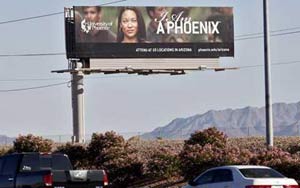|
 A 2009 photo of a billboard in Chandler, Arizona, advertising the University of Phoenix, a major for-profit chain of schools. |
President Obama wants the United States to have the world's highest rate of college graduates. But his administration also wants stronger rules for colleges that operate for profit.
Career colleges receive billions of dollars from taxpayers through student loans. The Education Department says some of that goes to waste and leaves students in debt for educations of little or no value.
To receive federal aid, career colleges must prepare students for what the law calls "gainful employment" in a recognized occupation. Two tests are proposed to see if they do.
One would measure the relationship between debt loads and how much students earn after they complete a program. The other would measure the rate at which all students repay their loans, whether they complete the program or not.
Programs that fail these tests could be restricted or blocked from federal student aid.
The Education Department says for-profit colleges and training programs are important. In 2008 they had close to two million students -- nearly three times more than in 2000.
Last year, the five largest received more than three-fourths of their money from federal student aid. And that amount did not include other forms of government aid.
Yet officials say for-profit colleges may be less supervised than other schools. They also point to reports of highly aggressive marketing.
For every 100 graduates of for-profit colleges, 18 fail to repay their federal student loans. That compares to five graduates of public colleges and universities.
The department is now collecting public comments on a number of negotiated rules. Some would require career colleges to release their graduation and job placement rates. The goal is to publish a final rule by November.
The Career College Association called the debt-to-earnings proposal unwise, unnecessary, unproven -- and unlawful. The group says it has found that students in higher priced programs are more likely, not less likely, to repay their students loans.
It says the move could eliminate programs serving 300,000 students. Female and minority students would face the most harm, it says, as they are more likely to attend career colleges.
The association also points to shrinking budgets for community colleges. Its president, Harris Miller, says "Students need more information, not fewer choices."
And that's the VOA Special English Education Report, written by Avi Arditti. I'm Steve Ember.
National standards for US schools gain support
In treating athletes, is trainer's sex an issue? Sometimes it is
Celebrating the 50th anniversary of 'To Kill a Mockingbird'
For foreign students, top choice in US: USC
(来源:VOA 编辑:陈丹妮)
